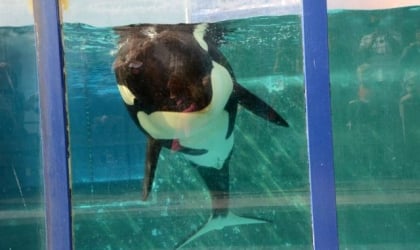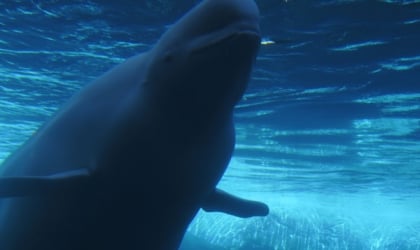Update: April 11, 2014
The D.C. Circuit’s decision today to the effect that SeaWorld must keep trainers out of the water signals an end to the days of trainers standing and riding on orcas for human amusement at SeaWorld. With the life-threatening dangers to trainers and the detrimental effects of enslaving intelligent, social, and far-ranging orcas and confining them to concrete tanks, SeaWorld’s tawdry shows will soon be a thing of the past. SeaWorld needs to make the only responsible and humane choice and develop coastal sanctuaries for the orcas it confines and finally bring its business into the 21st century.
Originally posted May 30, 2012:
There’s big news today in a case that PETA has been tenaciously pursuing for some time: Consistent with the citations issued against SeaWorld in 2010, Administrative Law Judge Ken Welsch of the Occupational Safety and Health Review Commission (OSHRC) found that SeaWorld is culpable for allowing its employees to interact directly with potentially dangerous orcas.
SeaWorld Knew the Risks
For years, PETA has implored SeaWorld to transfer the marine mammals it enslaves to transitional coastal sanctuaries because confining animals of such great size to severely inadequate tanks leads to miserable lives of desperation and frustration—and dangerous conditions for SeaWorld staffers.
After one orca, Tilikum, killed trainer Dawn Brancheau in front of horrified visitors at SeaWorld Orlando, PETA urged the Occupational Safety and Health Administration (OSHA) to pursue a citation against SeaWorld and provided it with compiled research on the history of deaths and injuries at the park and orca aggression in captivity. Today’s OSHRC decision affirms that SeaWorld knew that allowing its employees to interact directly with orcas such as Tilikum could have serious or fatal results.
A History of Irresponsibility
While the judge modified the citation for “willful” violations of the Occupational Safety and Health Act to “serious,” adjusting the fine accordingly, he found that SeaWorld knew that there was a “substantial probability that death or serious physical harm could result” from these interactions, yet it continued to allow them. He found SeaWorld’s arguments that it wasn’t aware of these hazards to be implausible and lambasted its corporate culture of placing the blame for dangerous incidents exclusively on trainers and discouraging trainers from stopping a show—even after an attack.
Information that came out of the testimony during a two-week hearing before Judge Welsch, as well as during previous proceedings, includes the following:
- A senior trainer testified that trainers who work with orcas receive special instruction on Tilikum as well as a “Tilly Talk,” in which they’re informed of Tilikum’s involvement with two previous deaths and that if they enter the water with him, they may not survive. Despite these concerns, trainers were approved to work in close proximity with him and physically touch him at the water’s edge.
- Chuck Tompkins, SeaWorld’s corporate curator for zoological operations, testified that there are no specific steps for trainers to follow to respond to a life-threatening situation in the water and that their lives are ultimately up to their own “best judgment call.” Tompkins admitted that the park does not even re-evaluate its protocols after an injury or death because it deems the injuries “a result of human error” and insisted that revising safety protocols is unnecessary. He also claimed that SeaWorld has “gotten a whole lot better” with the training process over time, despite, as government attorneys noted, the killing of two trainers in a two-month span.
- No high-level managers of animal training at SeaWorld are formally trained in animal behavior nor do they have any professional experience with orcas other that what they learned on the job at SeaWorld. In addition, the company has never called on an independent third party to review its incidents, protocols, or safety procedures.
- Senior SeaWorld employees oversaw orca training at Spain’s Loro Parque theme park when trainer Alexis Martinez was killed after being rammed and dragged underwater by an orca named Keto—just two months before Brancheau’s death. Judge Welsch saw through SeaWorld’s attempt to distance itself from this park, as the killer whales are leased from SeaWorld, SeaWorld trainer Brian Rokeach was stationed at Loro Parque to supervise animal training, and all decisions about animal care and training were made in conjunction with SeaWorld’s corporate headquarters.
While SeaWorld’s own corporate incident log contains reports of more than 100 incidents of orca aggression at its parks, government attorneys brought up incident after incident that were left out of the log, including the attack leading to Brancheau’s death and attacks by an orca who had a penchant for grabbing trainers’ ponytails. Yet despite the premature deaths of four human beings—one from extensive internal bleeding—and more than 20 orcas at SeaWorld’s parks, the company continues to put profits over humane concerns. Dawn Brancheau would be alive today if SeaWorld had heeded PETA’s advice.
How You Can Help Orcas at SeaWorld
You can help the animals imprisoned by SeaWorld today. Please take a moment to ask SeaWorld to develop a firm and rapid plan to release the animals to sanctuaries that can provide them with a more natural environment.





